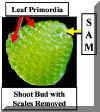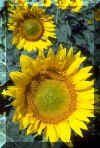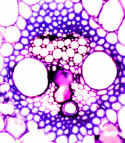 Bottom |
 Next Page |
 Bottom |
 Next Page |
Seedless Plants like ferns, typically have Apical Cells as their Apical Meristems. This is similar to what we saw with Roots. These apical cells are shaped like an inverted pyramid and divide anticlinally to produce Derivative Cells. These, continue to divide in various planes and produce the shoot system. (E pluribus unum).
The stems of seed plants do not have apical cells. Some appear to have have discrete Initials similar to those we saw in some root apical meristems. However, shoot apical meristems of gymnosperms and angiosperms are clearly multicellular.
The apical dome is usually convex or flat and its surface is smooth. However, small protrusions can be seen when the macroscopic leaves are carefully removed. These small protrusions are Leaf Primordia. The smallest of these is the one most recently produced. The term Node is used to indicate that place on the stem where a leaf is inserted. An Internode is that portion of a stem between successive nodes. This terminology will be reviewed below.
| Shoot Apex Covered by Immature Leaves | SAM with Leaves Removed. The actual SAM is the slightly convex area in the center surrounded by Leaf Primordial. |
The "Meristem Proper" is that part of the shoot apex which is ABOVE the youngest leaf primordium. The term "Shoot Apical Meristem" (SAM) refers to the meristem proper. The "Shoot Tip" would include the youngest leaf primordia and the meristem proper. This is an important consideration for plant propagation via "tissue culture". Bacteria and viruses can penetrate the shoot tip but can't do so with the meristem proper. Meristem culture refers to the excision and culture of the pathogen-free meristem proper. Shoot tips can also be cultured and they are easier to grow than true apical meristems. However, the chances for contamination are much greater. The differences in productivity between pathogen-free plants and contaminated plants is staggering, and makes it well worth the extra effort for horticultural crops.
This terminology has basic scientific significance because it allows us to readily and unambiguously discuss these closely-related parts of the shoot system.
 |
 |
| Dome-Shaped SAM | Orchid SAM - Note the staining density of the Meristem Proper and its relatively flat appearance. |
A careful examination of the
shoot apical  meristem (SAM) shows that leaf
primordia are produced in precise geometric patters. The term phyllotaxy is used to refer to these geometric patterns. The
phyllotaxy is best seen in buds which have preformed leaf primordia like those in
Spruce (Picea). It is possible to trace the progression of primordia that will
produce helical files of mature leaves once the bud has expanded. These tracings are
called contact parastices and can be used to describe the
phyllotaxy of the plant. The precise phyllotactic patterns of different plants have been
used to design clever experiments on the control of leaf origination and differentiation.
The leaves are closely inserted at the apex and there is little internodal elongation.
However, as older leaves are displaced by new leaves, the former begin to grow rapidly
along with the stem. We will say more about leaves later.
meristem (SAM) shows that leaf
primordia are produced in precise geometric patters. The term phyllotaxy is used to refer to these geometric patterns. The
phyllotaxy is best seen in buds which have preformed leaf primordia like those in
Spruce (Picea). It is possible to trace the progression of primordia that will
produce helical files of mature leaves once the bud has expanded. These tracings are
called contact parastices and can be used to describe the
phyllotaxy of the plant. The precise phyllotactic patterns of different plants have been
used to design clever experiments on the control of leaf origination and differentiation.
The leaves are closely inserted at the apex and there is little internodal elongation.
However, as older leaves are displaced by new leaves, the former begin to grow rapidly
along with the stem. We will say more about leaves later.
 |
 |
| Vegetative Bud of Spruce - Note the highly organized leaf primordia. | Vegetative Bud of Spruce with three contact parasticies indicated |
Flowering plants (Angiosperms) have a type of SAM architecture called Tunica-Corpus organization. The outermost layer of cells divide anticlinally to produce the Protoderm. The protoderm becomes the Epidermis. This is the Tunica! In some cases there is only one Tunica layer. This covers the Corpus. Cell divisions in the Corpus occur in various planes and produce the Ground Meristem and Procambium which comprise the rest of the shoot.
Scientists love simplicity and consistency and it would be great if this was the only type of apical organization seen in seed plants. However, there are a few complications. In some cases there may be two or more Tunica layers. However, only the outer layer contributes to the Epidermis. The other two contribute to interior tissues.
 |
|
| Long Section of a typical Dicot SAM | Embossed
Image of an SAM - Note the 2-3 Tunica Layers. Ok if you say so!!!!!! |
Tunica Tunica on the Wall .....................
Ginkgo (a gymnosperm) SAM with Leaf Primordia - Note the Tunica-like Layer which is continuous with the Epidermis of the Leaf Primordia. |
Gymnosperms like Norfolk Island Pine (Araucaria) are also seed plants. Their apical organization can appear to be complex when the cytology of their cells, and their organizational patterns are considered. Meristematic cells are supposed to be dividing cells. Dividing cells are relatively small. However, the central cells in gymnosperm apices are often very large and they appear to divide rarely. Consequently, the Tunica Corpus model may not be sufficient to describe the architecture of these apices. The large centermost cells in both the Corpus have been called "Central Mother Cells" and various parts of these apices have received names based on their apparent division planes, and their frequencies of cell division. The example given below (Ginkgo) is relatively simple compared to most gymnosperms. However, it is sufficient to illustrate the general features of gymnosperm SAMs.
It is hard to delimit regions of the SAM based on cell size and staining.The outer Tunica layer is obvious in virtually all SAMs. One can usually point to the general location of the Corpus because of the rapid enlargement and vacuolation. of the ground tissues, and the densely cytoplasmic and elongated procambial cells which distinguish them from the Corpus. However, this is rather vague and imprecise.
Gymnosperm SAM - Note the relatively large size and faint staining of cells in the apex center. These comprise the Central Mother Cell Zone (CMZ). Note the dense staining and evidence of mitosis in the Peripheral Zone immediately outside the CMZ. |
|
| SAM with Hypothetical Locations of the Quiescent Center (Red) and Peripheral Zone (Yellow) |
Mitotic cells synthesize DNA rapidly. When they are incubated with radioactive thymidine (remember A:T G:C) mitotic cells accumulate more thymidine than quiescent cells. When shoot tips are incubated with radioactive thymidine, the cells at the very apex, including Tunica & Corpus do not label heavily. However, subtending cells in both regions are heavily labeled. Experiments with several species have yielded similar results. When the rates of cell division were carefully and painstakingly analyzed in SAMs, it became clear that the apical quiescent cells did not divide frequently. However, they did divide given sufficient time. These cells were called the Quiescent Center (QC).The cells on the periphery of the QC labeled heavily with thymidine and divided rapidly. This confounded botanists and appeared to be a contradiction. However this actually provides a unifying concept, and that is what science truly seeks, at least that is what I believe.
It appears that virtually all SAMs have a Tunica layer on the surface of the meristem proper. This divides anticlinally and gives rise to the Protoderm.
The surface Tunica layer covers a multicellular, dome shaped region in which anticlinal, periclinal and oblique divisions occur. The latter is the Corpus or Central Mother Cell Zone (CMCZ). Let's agree to use the term CORPUS to mean Corpus & the CMCZ!
Cells at the summit of the SAM, including both the Tunica & Corpus divide infrequently and constitute the Quiescent Zone. Subtending cells divide rapidly and form the Peripheral Zone. One can distinguish various regions of the PZ based on the planes of cell division etc. However, the latter is not as important as the concept of the Quiescent Center and the Peripheral Zone. One way to think of this would be to imagine that the Quiescent Zone is a multicellular Apical Cell from which all other cells are derived. This is probably botanical blasphemy but it is a valid analogy.
The cells
of the QZ can be stimulated to divide rapidly by wounding. This can lead to the
formation of two or more shoots. These will eventually form QCs in their SAMs. Consequently, the
QC might provide a reservoir of cells to protect against damage to the apex.
QCs in their SAMs. Consequently, the
QC might provide a reservoir of cells to protect against damage to the apex.
Some plants like sunflower have large QCs. These plants form a large terminal inflorescence. Cells in the QC divide rapidly at the onset of flowering and produce the large floral head. This represents a special case, however.
It is known that mistakes are made in DNA synthesis after mitosis. It has been argued that if the "initials" present in SAMs divided frequently, mutations would accumulate in these cells. This could lead to abnormal growth or the production of genetically inferior gametes. The negative consequences of these are obvious.
Thus, cells in the QZ may constitute a genetic vault which produces a few derivatives during the growth of a stem but hoards most of its genetic assets. The derivative cells divide furiously until they are exhausted, at which time the vault releases some fresh currency. When flower production is induced, the vault releases all of its genetic assets which divide and form the organs of the flower. This would include the gamete forming tissues in the anther and ovary.
Root
Apical Meristems also have Quiescent Centers . It is thought that this QC gives the root tip the ability to survive severe
insults to the Root Cap and the PZ. Indeed, isolated QCs of roots can regenerate complete
roots.
Centers . It is thought that this QC gives the root tip the ability to survive severe
insults to the Root Cap and the PZ. Indeed, isolated QCs of roots can regenerate complete
roots.
 Top |
 Next Page |